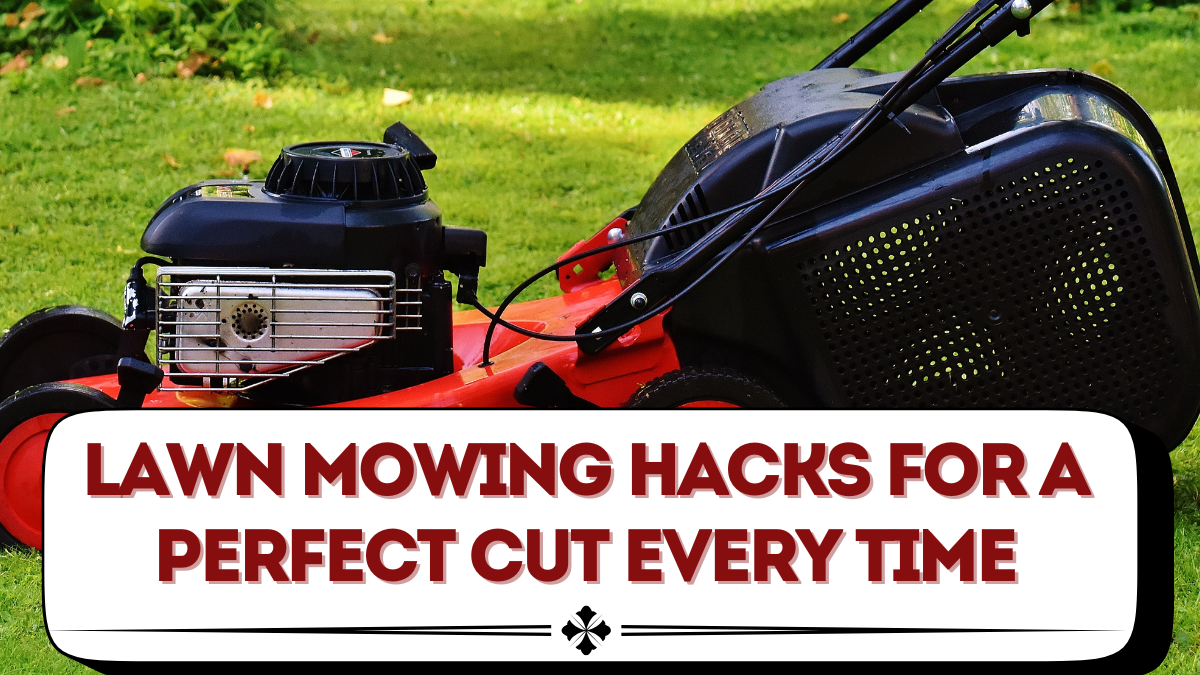A lush green lawn doesn’t come only from fertilizers and watering—it also depends heavily on mowing practices. Many homeowners cut their lawns without realizing that mowing methods directly influence grass health. With the right lawn mowing hacks, you can encourage deeper roots, improve grass density, and reduce weeds, all while saving time and effort.
This article explores the best tips and techniques for mowing your lawn correctly. From choosing the right mowing height and blade type to setting an optimal cutting schedule, these strategies will help you achieve a lawn that looks professionally maintained year-round.

Why Proper Mowing Matters
Mowing isn’t just about keeping your lawn short. It affects photosynthesis, root growth, and even soil temperature. When grass is cut too short, it loses energy reserves and becomes more prone to weeds, drought, and disease. On the other hand, mowing at the right height stimulates root development, leading to a stronger, more resilient lawn.
Healthy mowing practices also reduce stress on the grass, allowing it to recover faster and stay greener through the season.
Lawn Mowing Hacks That Make a Difference
1. Follow the One-Third Rule
Never remove more than one-third of the grass blade in a single mowing session. Cutting too short shocks the grass and weakens roots.
2. Adjust Mowing Height Seasonally
-
In summer, keep grass slightly longer (3–4 inches) to shade soil and conserve moisture.
-
In spring and fall, mow a little shorter (2–2.5 inches) to prevent fungal growth.
3. Use Sharp Blades
Dull mower blades tear grass instead of cutting it, leaving ragged edges that turn brown. Sharpen blades at least twice per season for clean, healthy cuts.
4. Switch to Mulching Blades
Mulching blades finely chop clippings and return them to the soil as organic fertilizer. This reduces thatch and improves soil fertility naturally.
5. Mow in Different Directions
Change mowing patterns each week to prevent soil compaction and promote upright grass growth.
6. Avoid Mowing When Wet
Wet grass clumps together, clogging the mower and leaving uneven patches. Always mow when grass is dry.
7. Leave Grass Clippings
Clippings act as free fertilizer, returning nitrogen and organic matter back to the lawn. Only bag clippings if the lawn is overgrown.
Choosing the Right Mowing Equipment
Your choice of mower impacts lawn health as much as mowing practices.
Types of mowers to consider:
-
Reel Mowers – Eco-friendly, give a clean scissor-like cut, ideal for small lawns.
-
Rotary Mowers – Versatile and powerful, suitable for medium to large lawns.
-
Mulching Mowers – Specially designed blades that recycle clippings into natural fertilizer.
-
Robotic Mowers – Automated systems that maintain consistent grass height with minimal effort.
Comparison of Mowing Heights
| Grass Type | Recommended Height | Seasonal Note |
|---|---|---|
| Cool-season (Fescue, Rye, Bluegrass) | 2.5–3.5 in | Raise in summer, lower in spring/fall |
| Warm-season (Bermuda, Zoysia, St. Augustine) | 1–2.5 in | Keep short in summer for best growth |
| Mixed Lawns | 2–3 in | Adjust depending on dominant species |
Correct mowing height varies by grass type, so it’s important to know your turf species.
Frequency of Mowing
How often you mow depends on grass growth rate, not just the calendar.
-
Cool-season grasses grow fastest in spring and fall; mow weekly during these periods.
-
Warm-season grasses grow more in summer; mowing may be required every 5–7 days.
-
During drought or slow growth, reduce mowing frequency to avoid stressing grass.
A good rule of thumb is to mow whenever grass grows beyond one-third taller than the recommended height.
Smart Lawn Mowing Hacks for Efficiency
-
Mow in the morning or evening to avoid heat stress on grass.
-
Trim edges first for a neat, professional look.
-
Use string trimmers for corners and hard-to-reach areas.
-
Keep mower deck clean to ensure even airflow and cutting.
-
Overlap slightly with each pass to avoid missed strips.
Seasonal Lawn Mowing Guide
Spring
Start with a cleanup mow at a lower height to remove dead grass and debris. Increase mowing frequency as growth accelerates.
Summer
Raise mowing height to shade the soil and reduce water loss. Avoid mowing during midday heat.
Fall
Gradually lower the height to prepare grass for winter. Collect fallen leaves or mulch them into the lawn.
Winter
In mild climates, mow occasionally to prevent overgrowth, but avoid cutting dormant grass too short.
FAQs
What is the best mowing height for most lawns?
Most lawns thrive at 2.5–3.5 inches, but this varies based on whether you have cool- or warm-season grass.
Should I bag or mulch my clippings?
Mulching is better for lawn health, as it recycles nutrients back into the soil. Bag only if clippings are too long.
How often should I sharpen mower blades?
At least twice a season, or more often if you notice tearing instead of clean cuts.
Is mowing too short really harmful?
Yes, scalping weakens roots, encourages weeds, and makes the lawn more prone to drought and pests.
Are robotic mowers worth it?
Yes, for busy homeowners. They save time and maintain consistent grass height with little effort.
Conclusion
Healthy grass starts with smart mowing practices. By applying these lawn mowing hacks—like following the one-third rule, adjusting mowing height seasonally, using mulching blades, and mowing in different directions—you can achieve a lawn that stays lush, green, and resilient. With the right equipment, sharp blades, and a thoughtful mowing schedule, you’ll reduce effort, improve soil health, and enjoy a yard that looks professionally maintained.
Click here to know more.
